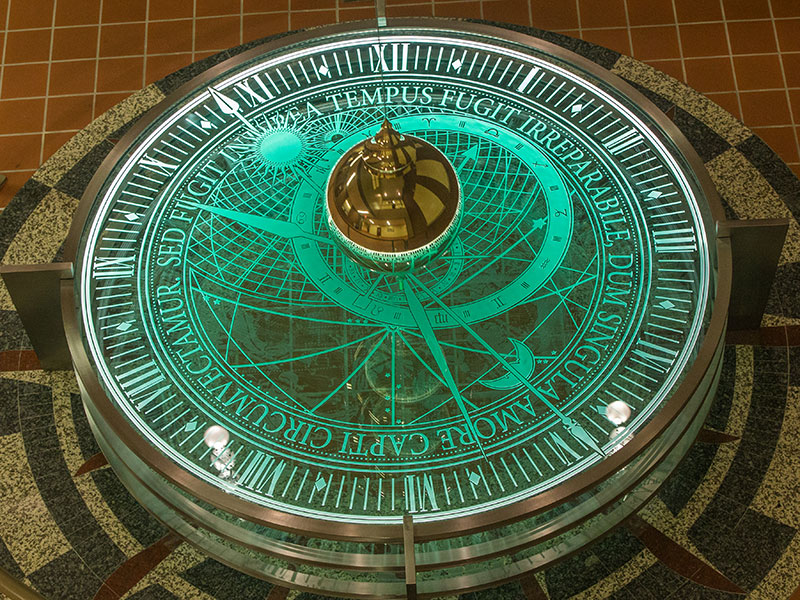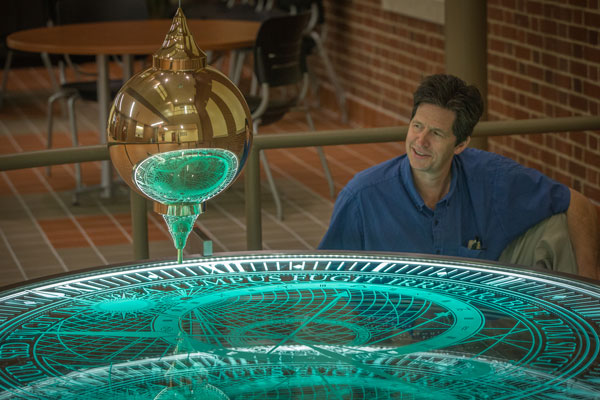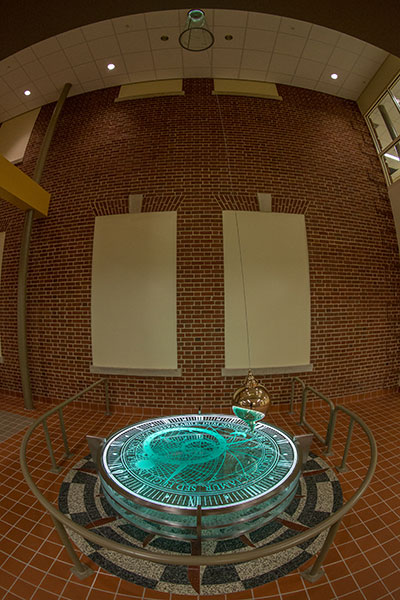

Back in the swing of things: Foucault Pendulum in motion at Kreger
Timeline
1961- Culler Hall is built specifically for Miami’s physics department and named for Joseph Albertus Culler, physics professor.
1965- The Foucault pendulum, designed by Joseph Roger Priest, physics professor, is installed in Culler Hall.
1968- Hughes Hall is renamed Kreger Hall in honor of Clarence W. Kreger, chemistry professor, who helped develop Miami’s School of Applied Science.
2006- Miami’s School of Engineering and Applied Science (now the College of Engineering and Computing) moves to its new location, vacating Kreger Hall.
2008- Kreger is taken offline in anticipation of state funding for building renovations.
2009 and 2010- No state appropriations for renovation projects are distributed.
2011- State funds are allocated for renovation and designs to Kreger Hall are resumed.
2014- Renovations to Kreger Hall are finished, and the physics department moves from Culler Hall. Miami’s geology and geography departments relocate to Culler Hall to accommodate renovations to Shideler Hall.
2016- Shideler Hall will reopen to the geology and geography departments, as well as the Institute for the Environment and Sustainability. Renovations on Culler Hall will begin as phase two of the Armstrong Student Center.

David Griggs earned his master’s degree in fine arts at the University of Colorado at Boulder. He’s created more than 45 commissioned works of art in the United States and Canada and says his work “embraces the character of a situation and embodies the spirit of a site.” (Photo by Scott Kissell)
by Ritter Hoy, university news and communications
Miami’s physics department may have gotten a new house last year, but it never really felt like home — until now.
Missing was the department’s famed Foucault Pendulum. It couldn’t be moved from Culler Hall when the department relocated to Kreger Hall because it was too big.
“It’s a focal point of our department,” said Teresa Kolb, an administrative assistant in the physics department. “We missed it.”
Herbert Jaeger, chair of the physics department, said many people had expressed concern about the pendulum’s fate when construction plans for Culler and Kreger halls (see timeline) were announced. The department had bigger plans for its special attraction.

To recognize the state’s responsibility to “foster culture and the arts,” Ohio’s Percent for Art legislation was approved in 1990. The legislation requires 1 percent of total appropriation funds be allocated to acquire, commission and install artwork in renovated public buildings. (Photo by Scott Kissell)
“As major funding for the remodeling of Kreger Hall came from the state of Ohio, we were always committed to using 1 percent of the total appropriation from the state for art,” Jaeger said.
That art is the physics department’s new Foucault Pendulum.
The pendulum’s artist, David Griggs, says he based his design on what he saw on his first visit to campus.
“The design of the pendulum and its finishes were inspired by what's around it and the nice architecture, the fine finishes, the new facilities, the Armstrong Center, some of the really nice campus amenities,” said Griggs.
The fixed point is a lit glass cone etched with images from the Hubble space telescope. At the end of the mass rod is a bob of brass weighing 230 pounds. At the end of the bob are three tiers of lit and etched glass, each representing different and equally important ideas to physicists.
“The first layer you see is an astronomical clock,” said Griggs. “It tells us the time, the date and the season and is based on a 365-day cycle.
“The middle layer is a map of Oxford from the 1800s. The square on the map represents the location of Miami University.
“The bottom layer represents the constellation figures of the Northern Hemisphere.”
The base of the pendulum is a traditional compass rose, appropriately positioned by its location in the building. It’s made of three colors of water jet-cut granite and is embedded in the floor of Kreger.
Griggs was on campus this week to make sure his design elements of the pendulum were perfect.
“I am very happy,” he said. “I wanted to make a connection between science, Miami University and Oxford, and the pendulum accomplishes that.”
The Foucault Pendulum is on the second floor of Kreger Hall, adjacent to a study area and across the hall from the physics office.
Kolb couldn’t miss it now if she tried.
Editor's note: In the video, artist David Griggs refers to the pendulum as being associated with the geology department. He was referring to Miami’s first Foucault Pendulum, still located in Culler Hall which is now home to the geography and geology departments.
